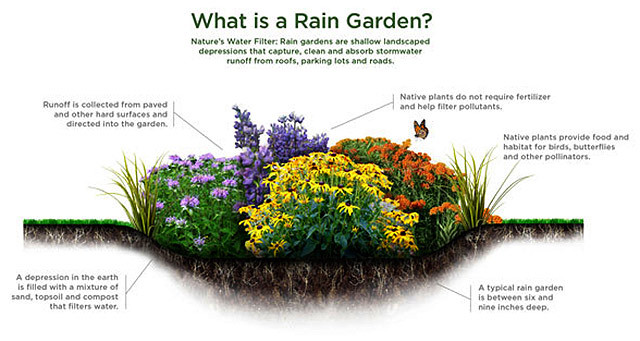
Rain Garden: Add Beauty & Function to Your Property
What is a rain garden?
A rain garden is a collection of native shrubs and perennial plants planted in a small depression or low lying area of the yard designed to hold and soak in rainwater runoff from roofs, driveways, and patios. When properly planted with native shrubs, grasses, and flowering perennials; rain gardens can be a cost-effective and attractive way to reduce runoff from leaving your property. Acting as a natural filter, rain gardens effectively remove up to 90% of excess nutrients and chemicals and up to 80% of sediments.
A rain garden is not designed to be a water garden, pond or wetland. They are dry most of the time only holding water during and following a rainfall event. Rain gardens drain within 12-48 hours of a rain event, preventing the creation of mosquito breeding grounds.
Rain gardens can also provide food and shelter for native pollinators, butterflies, songbirds, and other wildlife. In reality when properly planned your entire landscape can be a giant rain-garden.

Photo Credit: The Nature Conservancy
Choosing a location for your rain garden: Where do I start?
The best way to choose a location for your rain garden is to take a look at your yard after a rainstorm for naturally occurring low spots where rainwater collects. Low lying areas provide a prime location for your rain garden. If you’re lucky enough to not have a natural depression in your yard, you will need to choose a suitable location.
Rain gardens can be placed anywhere in the lawn, however, most sources recommend no closer than ten feet from the foundation of your home. Placing your rain garden closer than 10 feet to your foundation opens the risk of water seeping into your basement or crawlspace. Since rain gardens are not only functional but also beautiful, locating them close to the house allows them to blend into any existing landscape design.
What if my soil is nothing but clay?
Clay soils slow the absorption of water into the sub-soil making them ideal for creating a rain garden. Not sure what type of soil you have? Most state extension services will perform an analysis of your soil for a nominal fee. If the test indicates you have sandy soil, you will need to add water-absorbing compost and topsoil to the rain garden area.
If you’re worried about the percolation of your existing soil you may excavate the chosen area to a depth of 18 to 36 inches. Refill the area with soil mix you can create from the following ratios leaving a 6” deep area for which allows the collection of water on the surface. Your rain garden depth will likely be between 18 to 36 inches deep, with 6 inches ponding area and 12 to 30 inches of soil amendments.
An ideal mix ratio for soil in a rain garden is as follows:
- 50%-60% sand
- 20-30% topsoil (low clay content)
- 20-30% locally sourced compost
What plants are best for a rain garden?
As you create your rain garden, choose plants that can tolerate wet sites. Native plants work best and once established, regionally native plants require little water beyond the normal rainfall in your area. Because native plants are adapted to local soils and climate conditions, they rarely require fertilizer and are more resistant to pests and diseases than are other species. A general rule of thumb is to incorporate native grasses, sedges and rushes in at least one-third to one-half of the rain garden as these plants possess extremely deep root systems.
Our Top 5 Favorite Rain Garden Plants:
1. Calamagrostis Karl Forester
2. Winter Red Winterberry Holly
4. Asclepias incarnata Swamp Milkweed
Different areas of the rain garden may vary significantly in soil type or exposure to sun and wind, as well as evaporation rates and moisture levels. Placing plants that prefer shade in the open sun will affect their ability to thrive. Be mindful of a site's exposure to the elements and choose plants that will thrive in the site's conditions.
Caring for your rain garden
In the first-year, mulch open areas generously with shredded hardwood mulch. Do not use pine bark or wood chips as these will float away during heavy rainfall.
Weed your rain garden regularly during the first-year. Once established, the native plants you’ve selected will self-seed, spread, and will be able to out-compete weeds for light and nutrients. Weeding will be minimal if needed at all after the first year. Add large decorative rocks at the garden's entrance if your rain garden is located on a slope. This will prevent heavy rain from washing out young plants.
Water your new garden about an inch per week during the first-year until they develop a mature root system. If you select native species for your rain garden, you'll find that these plants will be highly tolerant of dry conditions once they mature.
Remember an individual rain garden may seem like a small thing, but collectively they produce substantial neighborhood and community environmental benefits. Saving our environment starts with small steps. Get your neighbors involved. Rain gardens can be contagious.
Rain Gardens are more than just a place to collect water. They provide habitat for beneficial insects and songbirds. They help clean the water that would normally end up in our waterways and ultimately in our drinking water. The construction of a rain garden is a task that an average homeowner can undertake with a bit of guidance and planning. Include children in the process all the way from design to completion. Rain Gardens are a great way to teach children about environmental stewardship and responsibility.
